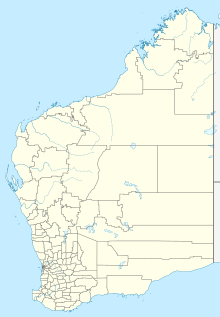Derby Airport | |||||||||||||||
|---|---|---|---|---|---|---|---|---|---|---|---|---|---|---|---|
| Summary | |||||||||||||||
| Airport type | Public | ||||||||||||||
| Operator | Shire of Derby/West Kimberley | ||||||||||||||
| Location | Derby, Western Australia | ||||||||||||||
| Elevation AMSL | 24 ft / 7 m | ||||||||||||||
| Coordinates | 17°22′19″S 123°39′45″E / 17.37194°S 123.66250°E | ||||||||||||||
| Map | |||||||||||||||
 | |||||||||||||||
| Runways | |||||||||||||||
| |||||||||||||||
Derby Airport (IATA: DRB, ICAO: YDBY) is located 5 nautical miles (9.3 km; 5.8 mi) southeast[1] of Derby, Western Australia.
History
[edit]
The site of Derby airport was first set aside for aviation uses in 1922.[2] The airfield played a key role in the search for Charles Kingsford Smith's Southern Cross following a forced landing in the Kimberley region during 1929 in an incident that would become known as the "Coffee Royal Affair".[citation needed] Aviation pioneer Norman Brearley used aircraft of his West Australian Airways in the initial search effort flying outwards from Derby.[3]
In 1938, it was proposed that Derby to be used as a base for flying boat services carried air mail from London to Australia via Egypt and Ceylon (Sri Lanka).[4]
See also
[edit]- Curtin Airport, nearby military base which hosted commercial passenger flights to Derby
- List of airports in Western Australia
- Aviation transport in Australia
References
[edit]- ^ a b YDBY – Derby (PDF). AIP En Route Supplement from Airservices Australia, effective 28 November 2024, Aeronautical Chart
- ^ "Shire of Derby / West Kimberley - Facilities - Airports - Derby Airport". Archived from the original on 27 November 2012. Retrieved 12 July 2012.
- ^ "Australia - Historical Stories". Archived from the original on 3 May 2012. Retrieved 12 July 2012.
- ^ "Derby May Be New Bose For Flying Boat Service". Sunday Times (Perth, Wa : 1902 - 1954). 30 October 1938. p. 1 – via Trove.
External links
[edit]
